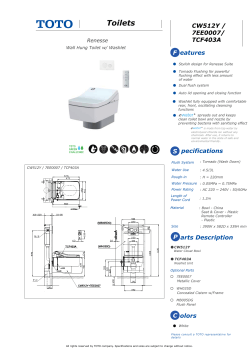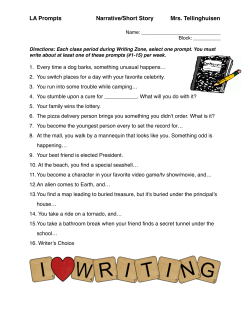
2015 Tornado and Severe Weather Awareness Drill Information
2015 Tornado and Severe Weather Awareness Drill Scheduled for Thursday April 16, 2015 The 2015 Tornado Drill will consist of a mock tornado watch and a mock tornado warning issued for all of Wisconsin. This is a great opportunity for your school, business and community to practice your emergency plans. DRILL SCHEDULE: 1:00 p.m. – National Weather Service issues a mock tornado watch for all of Wisconsin (a watch means tornadoes are possible in your area. Remain alert for approaching storms). 1:45 p.m. - National Weather Service issues mock tornado warning for all of Wisconsin (a warning means a tornado has been sighted or indicated on weather radar. Move to a safe place immediately). 2:00 p.m. – End of mock tornado watch/warning drill The tornado drill will take place even if the sky is cloudy, dark and/or rainy. If actual severe storms are expected in the state on Thursday, April 16, the tornado drill will be postponed until Friday, April 17 with the same times. If severe storms are possible Friday, the drill will be cancelled. Any changes will be issued to local media as well as posted on the ReadyWisconsin website, Facebook and Twitter pages. Most local and state radio, TV and cable stations will be participating in the drill. Television viewers and radio station listeners will hear a message at 1:45 p.m. indicating that “This is a test.” The mock tornado warning will last about one minute on radio and TV stations across Wisconsin and when the test is finished, stations will return to normal programming. In addition, alerts for both the mock tornado watch and warning will be issued over NOAA weather radios. Be sure your weather radio is turned on for this test. If the alarm on your weather radio does not go off for this test, check your weather radio's programming and quality of reception. This is a great opportunity for you to practice your tornado emergency plan with family, friends, and co-workers. Schools will also participate in the drill. During storm season – follow this message: Listen, Act and Live. Don’t ignore watches and warnings. Listen and take action. Every second counts. Don’t wait… go to a safe place right away! The drill will also occur at the same time in Minnesota and Michigan and will be broadcast on radio and TV stations in those states as well. Frequently Asked Questions about the Tornado Test How does the National Weather Service deliver this tornado test and real tornado watches and warnings? They use a notification program called the Emergency Alert System or EAS. What is the Emergency Alert System (EAS)? EAS is a national public alert and warning system that enables the President of the United States to address the American public during extreme emergencies. Alerting authorities like the National Weather Service can also use the state and local EAS to send alerts and warnings to radio and television stations, cable television, and NOAA weather radios (also known as emergency weather radios). Why do this test? The National Weather Service, Wisconsin Emergency Management and the Wisconsin Broadcasters Association believe it is important to allow the public to test their NOAA weather radio receivers which can only be activated using a real tornado warning code. The code also triggers the alert to air on most broadcast radio, TV and cable stations. The goal of any drill is to test all electronic systems that alert Wisconsin citizens to impending severe weather that can result in the loss of life and property. What can I expect to hear/see? The test may look like a regular EAS test that most people are already familiar with, but there will be some differences in what viewers will see and hear. The audio message will repeat “This is a test.” The video message scroll may not indicate “This is a test” due to programming limitations. The message will last for approximately one minute and then regular programming will resume. Where will I hear/see the test? On all participating radio, television, cable providers (who are called EAS Participants) and NOAA Weather Radios. When will the test occur? April 16 at 1:00 p.m. CDT for the mock tornado watch, and at 1:45 p.m. CDT for the mock tornado warnings. At 2:00 p.m. CDT, the tornado test will end. What else might happen? Many communities will activate their outdoor warning sirens for the test at 1:45pm. What would cause the test to be postponed or cancelled? The tornado drill will take place even if the sky is cloudy, dark and/or rainy. We realize a cloudy, dark sky with rain may look threatening to some people. However, this is not a hazardous situation that results in a direct loss of life and/or property. If actual severe storms are expected anywhere in Wisconsin on Thursday, April 16, the tornado drill will be postponed until Friday, April 17 at the same times. If severe storms are possible Friday, the drill will be cancelled. Severe weather is defined as tornadoes, damaging thunderstorm wind gusts of 58 mph or more, or large hail 1 inch in diameter or larger. Any changes will be issued to local media as well as posted on the ReadyWisconsin website, Facebook and Twitter pages. Are any other states participating in this test? Yes, the drill will also occur at the same time in Minnesota and Michigan and will be broadcast on radio and TV stations in those states as well. Will the Wireless Emergency Alert (WEA) be activated in my cell phone? No, the drill will not activate an emergency notification on your cell phone. But during actual tornado warnings your phone will alert you to the danger in your area. Tornado Safety at Home, Work, or at Play Listen, Act, and Live • • • • In a home or building, avoid windows. Move to a basement, and get under a sturdy table or the stairs. If a basement is not available, move to a small interior room or hallway on the lowest floor and cover yourself with towels, blankets or pillows. If possible, get under a sturdy table, desk or counter. Put as many walls as possible between you and the storm. Wearing a bike helmet will help protect your head. If outdoors, seek shelter in a sturdy building. If you cannot get to shelter, stay in your vehicle with the seatbelt on and place your head below the windows. Do not seek shelter under an overpass. Mobile homes, even if tied down, offer little protection from tornadoes. You should leave a mobile home and go to the designated storm shelter or the lowest floor of a sturdy nearby building. At school, go to the interior hall or room. Crouch low, head down, and protect the back of your head with your arms. Stay away from windows and large open rooms like gyms and auditoriums. (June 17, 2014 – Governor Scott Walker tours damage left behind by an EF 3 tornado which hit Verona in Dane County. At least 30 homes were damaged as well as the Country View Elementary School.) Tornado Safety Before the Storm: • • • • Develop a plan for you and your family for home, work, school and outdoors. Know the safest shelter areas in multiple locations. Have frequent drills. Keep a disaster supply kit in your home including water, food that won’t spoil and needs no heat to serve, first-aid kit, NOAA weather radio (also known as an emergency weather radio), a flashlight and special items for children, pets and elderly family members. Be sure your weather radio is working properly. Spring is a great time to install fresh batteries. Additional maps and information are also posted at http://readywisconsin.wi.gov. If you need further information, please contact your county or tribal emergency management director or Tod Pritchard at tod.pritchard@wisconsin.gov or 608-242-3324.
© Copyright 2025









